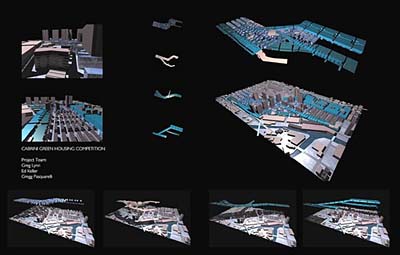Cabrini Green Urban Development Counterproposal

Initially conceived as an entry to the 1993 Cabrini Green housing competition in Chicago, this work was extended and used as an urban zoning counterproposal to try to envision a somewhat more radical solution to the problems posed by an utterly failed housing project like Cabrini.
The project began with an analysis that located various programs on the site, and areas of the site that could support interventions. It was possible to identify a set of extant housing typologies that appeared to work fairly well, which were left untouched, but also reiterated in a morphing 'screed' across the site.
Using a small water creature called a zooid as an organizational model, four massing programs (zones) were laid across the site: institutional, industrial, housing, and commercial. These 'hyperbars' began as linear bars, following the model of the zooid's first kind of self organization, which is a single file linear condition without individual specialization. Then, as the hyperbars were laid into the site, they were deformed to respond to local exigencies of program intensity and distribution, circulation, and built form on the site.
This deformation process followed the zooid's second mode of self organization, which is a forking and branching condition Greg Lynn termed the bifurcating zipper. After the initial analysis of the site, which took place on paper, we input the site into the computer. The hyperbars were developed using both our hands on paper, to arrive at a convincing way of morphing the housing screed, for example, but also using some images on the computer, and bending them in Photoshop to see how they might reconfigure on the site. The hand drawn linear hyperbars were then modeled on the computer, and laid into the site, where we were able to bend them within the virtual city, in response to the site conditions. Throughout this process the computer was used as a tool to work in an almost physical way with the models, by bending them, and also provided constant access to the condition of the moving section.
In the final iteration of the project, at a local level of detail, the hyperbars would change according to the third kind of self organization the zooids follow, an aggregate condition within which the individuals specialize in function, creating feeding organs, circulatory systems, genitalia, etc. Thus program organization at a local level would develop from these affiliating forces, as well as architectural detail.
PROJECT TEAM
Greg Lynn
Edward Keller
Gregg Pasquarelli
zones |
-
RETURN
| basilisk
MORE | GREG LYNN FORM
PREVIOUS | PORT AUTHORITY
NEXT | ANIMATION SUITE